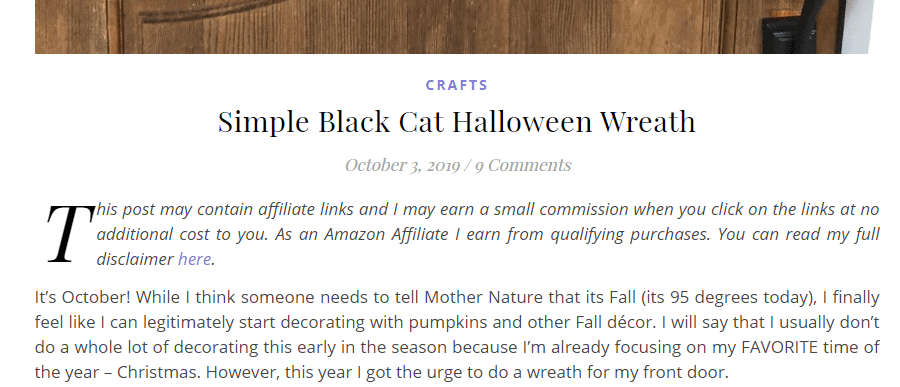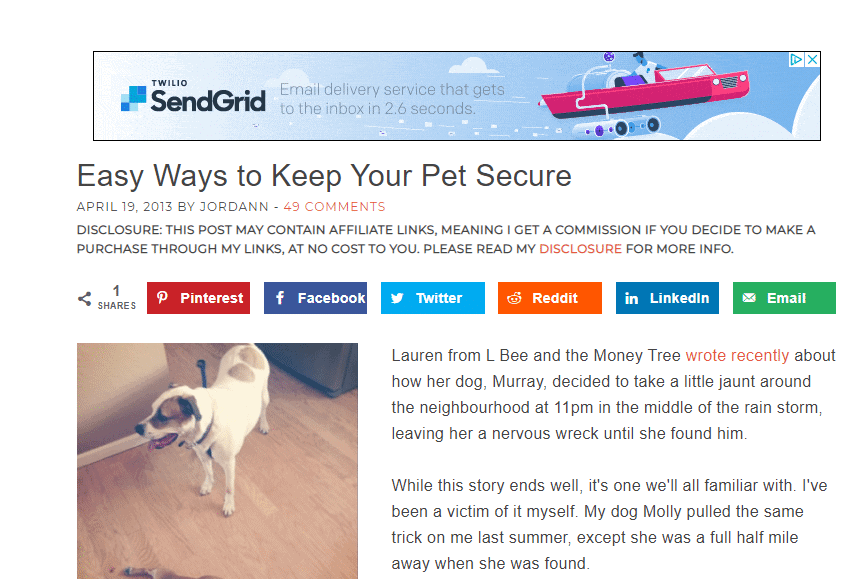Back in 2009, the Federal Trade Commission rolled out updated endorsement and advertising guides to help folks avoid deceptive and misleading endorsements and reviews in advertising.
There’s a lot of legalese, but fortunately for bloggers, the FTC breaks things down into a few common questions people ask, which are particularly useful for the types of blogs that make money (and lifestyle blogs).
Whether you’re starting a blog from scratch or you’re heavy into affiliate marketing, you must disclose when they may be compensated for making a recommendation.
If you’re looking to add an affiliate disclaimer to your blog or social media profiles, here are a handful of examples, ideas, and things to know so you can get it done and move on to the more fun parts of blogging.
Like blogging.
Also: this isn’t legal advice, I’ve just put together some of the more helpful affiliate disclosures I’ve found while doing keyword and competitive research.
Contents
11 Affiliate Link Disclosure Examples

1. Young House Love
Young House Love has a good example of making a disclosure with some voice and personality.
They have a separate page for the disclaimer, then add a small disclaimer text at the bottom of many of their articles like this one.
The only thing to note here is that the in-content disclaimer is at the bottom of the page, which is not necessarily a best practice according to the FTC, but it’s there nonetheless.
2. Southern Possibilities
Kate Troelstra’s disclaimer policy for Southern Possibilities is straightforward and covers the basics.
And a lot of times, that’s all you need.
She also does a great job of making her on-page disclaimer text front and center, at the beginning of posts like so, which is a great way to be as transparent as possible with your audience.

3. Joybilee Farm
Joybilee Farm has an interesting disclosure that addresses blogging compliance, as well as the fact that they don’t give out professional health information or advice.
Their in-content disclosure is also nice and transparent (example):
This post contains affiliate links. If you use these links to buy something we may earn a commission. Thanks.”
Right to the point. We dig it.
4. The DIY Nuts
The disclosure at The DIY Nuts is combined with their privacy policy.
Although the FTC recommends not burying yours in your privacy policy, they do a great job of making it clear this page discusses disclosure and privacy issues, so one isn’t hidden by the other.
They also have a great pre-content disclaimer on posts with some honest-sounding language and a link to their disclosure page:
*Disclosure: I only recommend products I would use myself and all opinions expressed here are our own. This post may contain affiliate links that at no additional cost to you, I may earn a small commission. Read full privacy policy here.“
5. The DIY Playbook
The DIY Playbook has some sponsored content, so they have a disclaimer at the top of posts like this one that says so.
It’s different than the affiliate marketing disclaimer, but if you offer sponsored content it’s good to lock down some disclosures in this area as well.
You can find Casey’s main disclosure information on her privacy policy page.
6. In My Own Style
Diane at In My Own Style does a great job of really breaking down her blogging business model on her disclosure page.
Readers get an immediate sense of how she operates her blog, including how she makes money and how those channels affect content.
This is one of the more in-depth and comprehensive disclosures I came across in my research.
7. Outside Magazine
Most of the disclosures here are from small one-person blogs, but big brands like Outside Magazine can also be a good source of disclosure ideas.
They have a simple, subtle disclosure at the top of gear-related articles like this, and their full affiliate policy page goes over more in-depth info.
It’s not as personal as some of the other examples, but it’s a good instance of a brand making sure they cover their bases.
8. The Wirecutter
The Wirecutter is another example of a big brand website doing disclosure well.
Their affiliate articles contain the disclaimer:
Wirecutter is reader-supported. When you buy through links on our site, we may earn an affiliate commission.”
And their “About Us” page goes over how they choose products, how affiliate marketing works with their business, and how they maintain a high level of objectivity.
They also use an easy Q-and-A format to answer questions about content and recommendations.
9. Driven by Decor
Kris at Driven by Decor has a quick and easy disclosure at the top of articles, and a full disclosure page that goes over affiliate links, privacy policies, and advertising.
It’s nothing to write home about, but again, she has it up, it’s there and it’s clear to readers on the site.
10. Remodelaholic
Cassity at Remodelaholic has quite possibly the longest disclosure page I came across, but that’s because it also includes privacy policies, advertising info, contact info, and a whole bunch of other stuff.
Fortunately, she includes jump links to each section, so you can scroll down to the affiliate information easily.
If you go this route and have one long page for all your legal info, it’s a great user experience to include these intro links so users don’t have to scroll forever to find your disclaimers.
11. Making Sense of Cents
Michelle at Making Sense of Cents is an excellent and massively successful blogger, and I’ve taken a few of her courses over the years.
So it’s no surprise that she does a great job with her disclosures.
She has a nice up-top disclaimer text before articles, and a link to a full disclosure page with some basic but explanatory text on FTC compliance.

She covers all her bases and makes sure her audience knows when something’s sponsored or an affiliate link.
In return, she’s grown a loyal and ever-growing audience that knows what to expect from Michelle on her blog.
What is an affiliate disclosure?
An affiliate disclosure or disclaimer is the language used to inform your audience that you have relationships with brands, products, services or companies you publicly recommend.
It can also explain what affiliate marketing is, and many times, your approach to marketing and choosing brands to recommend or represent.
At the most basic level, an affiliate disclosure is about being transparent with your audience and avoiding “deceptive” endorsements or recommendations.
“Under the law, an act or practice is deceptive if it misleads ‘a significant minority’ of consumers,” says the FTC.
“Even if some readers are aware of these deals, many readers aren’t.
That’s why disclosure is important.”
It may sound complicated, but it doesn’t have to be.
All a disclosure needs to do is disclose that you may be compensated for referring sales (affiliate marketing), or that you were paid to endorse something (sponsored content, etc.).
You can also disclose other endorsements, such as free products received.
Typically, bloggers have a small affiliate disclosure on individual blog posts that have affiliate links or sponsored content, and in many cases link to a separate page with more in-depth disclosure information for further reading.
Who needs disclosures?
Anyone who gets paid in some way to make public reviews can benefit from an affiliate disclosure.
That could include bloggers, social media influencers, television personalities, celebrities, and so on.
The FTC requires disclosures in order for audiences to understand “the reviewer’s relationship to the company whose products are being recommended,” so it’s less about who is doing the endorsement and more about how they do it.
If you blog and you’re an active affiliate for companies like Amazon, REI, etc., then you’re a reviewer and would need a disclosure.
Where should disclosures go?
There are no hard-and-fast rules on where affiliate disclosures should go, but the rule of thumb is to make them appear “clearly and conspicuously” on your site.
That means not burying your disclosure in your privacy policy, or putting it in weird colors at the bottom of your site.
One of the best practices you can follow is to put a quick disclosure up top, where readers can see it before getting to any affiliate links.
“The closer it is to your recommendation, the better,” says the FTC.
If you do this, you don’t need a big long disclosure before each blog post.
You just need something that mentions the disclosure and links to a longer disclaimer.
The FTC doesn’t recommend putting the disclosure after content, or in your footer, because it’s not clear to the reader as they get to affiliate links in the main content.
Depending on the affiliate programs you’re in, you may be required to show your disclosure front and center in order to help that retailer check all their legal boxes as well.
That said, where you ultimately put your disclosure info is up to you and your willingness to be transparent.
There are plenty of bloggers with buried disclosures, or none at all, so it’s really about how open and honest you want to be with your readers while staying FTC-compliant.
If you’re having trouble deciding where to place yours, consider using an affiliate disclosure plugin that automatically places it around your site as needed.
Writing Your Affiliate Disclosure
With these examples and ideas, hopefully, you have a better idea of what to write for your disclosure.
If not, there are templates out there, but it looks nice to have something specific to your blog, brand, and personality.
Whatever you do, don’t get hung up on the details, and make your disclaimer perfect.
Like most aspects of blogging, the important part is getting something up and live – not necessarily perfect.






